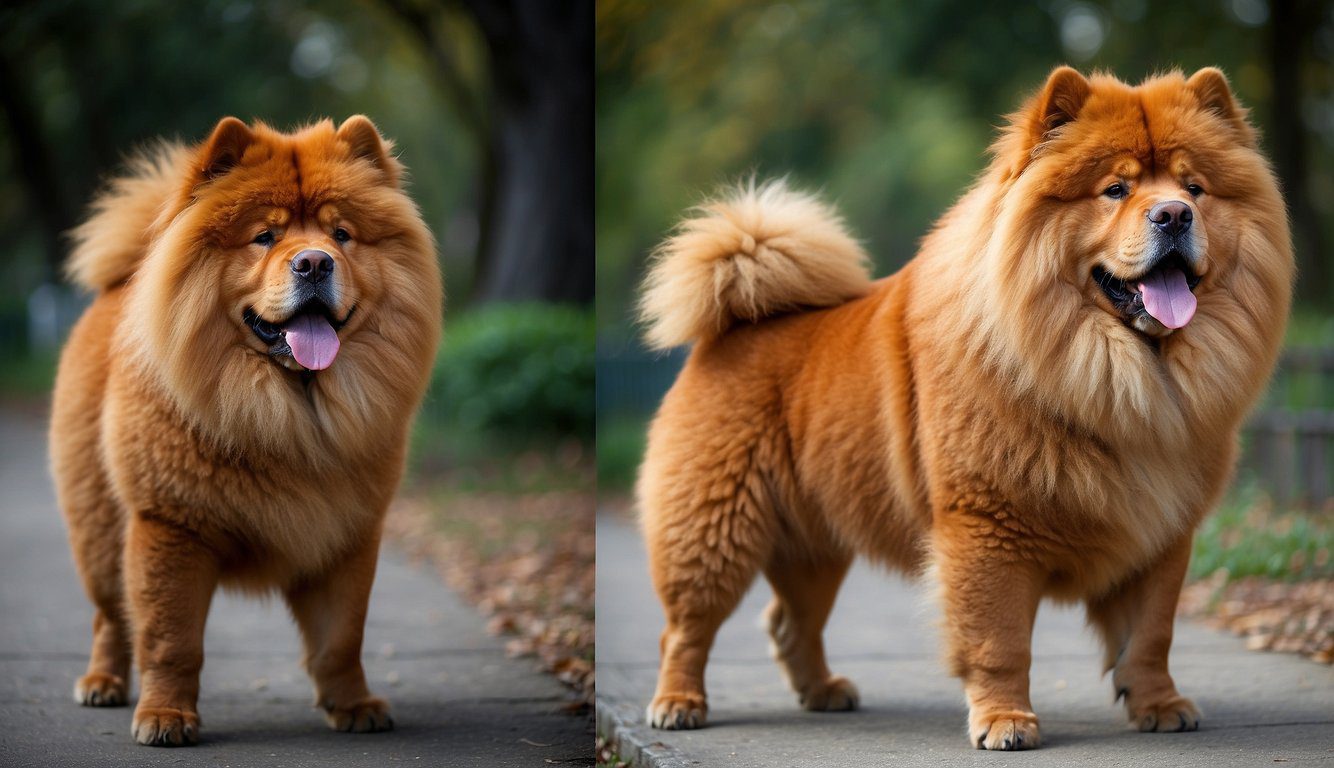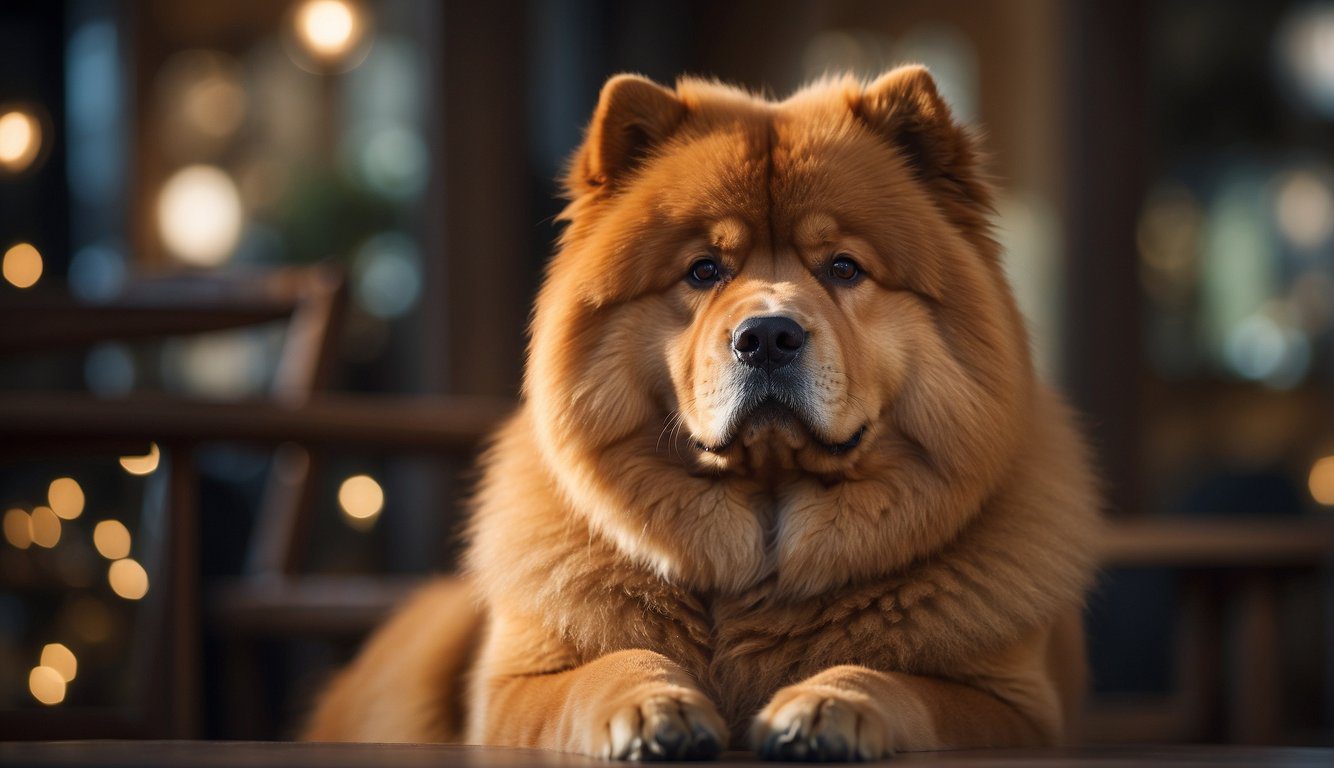What to Know
Red Chow Chow
Red Chow Chows, with their stunning, fluffy lion-like appearance, often face grooming challenges due to their thick double coats.
This can lead to matting and skin issues if not properly managed, causing discomfort and potential health problems for your beloved pet.
The Red Chow Chow is a striking and majestic dog breed known for its fluffy, lion-like appearance and dignified demeanor. These dogs sport a thick, double-layered red coat that can range from light cinnamon to deep mahogany, complemented by their distinctive blue-black tongue and a mane-like ruff around their neck.
Originating from ancient China, Red Chow Chows were historically used for hunting and herding, and today they are cherished for their loyalty and protective nature.
Regular grooming is essential to maintain their beautiful coat, and early socialization helps manage their independent and strong-willed personality.
With proper care and training, Red Chow Chows can be loving and loyal family companions. In this article, discover expert tips and solutions to keep your majestic Red Chow Chow looking and feeling their best.
Key Takeaways
- Red Chow Chows have a striking appearance with their fluffy red coats and bear-like features
- These dogs require regular grooming and have strong-willed personalities
- With proper care and training, Red Chow Chows can be loyal and loving family pets
Breed Overview

Red Chow Chows are a unique and striking dog breed. These fluffy companions have a rich history and distinctive traits that set them apart from other dogs.
Origin and History
Chow Chows have roots in ancient China, where they were prized for their versatility. You might be surprised to learn that these dogs were used for hunting, herding, and even as war dogs. Their name comes from the Chinese word for “puffy-lion dog.”
Over time, Chow Chows made their way to the West. In the late 1800s, they became popular in England and later in the United States. Queen Victoria’s fascination with the breed helped boost their popularity.
Today, you’ll find Chow Chows in homes around the world. They’re loved for their unique looks and loyal personalities.
Physical Characteristics
When you see a red Chow Chow, you’ll notice its lion-like appearance. These dogs have a sturdy build and a distinctive ruff around their neck.
Key features:
- Weight: 45-70 pounds
- Height: 17-20 inches
- Coat: Thick and fluffy
Red Chow Chows have a beautiful, deep red coat. It can range from a light copper to a rich mahogany. Their fur is dense and requires regular grooming to keep it looking its best.
One unique trait is their blue-black tongue. This is a hallmark of the breed and sets them apart from other dogs.
Temperament and Personality
Chow Chows are known for their dignified and aloof nature. You’ll find they’re loyal to their family but can be reserved with strangers.
These dogs are intelligent and independent. They may not be as eager to please as some other breeds, which can make training a bit challenging.
Early socialization is key. Expose your Chow Chow to different people, places, and situations when they’re young. This helps them become well-rounded adults.
While they’re not typically high-energy dogs, Chow Chows still need regular exercise. A daily walk and some playtime will keep them happy and healthy.
Coat Colors and Genetics
Chow Chow coat colors are diverse and fascinating. The genetics behind these colors involve complex interactions between genes. Let’s explore the rainbow of Chow Chow hues and the science that creates them.
Understanding Coat Colors
Red Chow Chows come in a range of shades. You might see deep mahogany, cinnamon, or golden tones. Each shade has its own charm.
Red isn’t the only color, though. You’ll also find black, blue, and cream Chow Chows. Each color has unique traits.
Some colors are more common than others. Red and black are often seen. Blue and cream are less frequent.
The Science of Canine Genetics
Two main pigments create Chow Chow colors: eumelanin and phaeomelanin. Eumelanin produces black and brown. Phaeomelanin gives red and yellow hues.
Genes control how these pigments appear in a dog’s coat. The A-locus and K-locus are key players. They determine color patterns.
Other genes can modify these basic colors. For example, dilution genes can lighten black to blue.
Color Variations Within the Breed
You’ll find a wide range of colors in Chow Chows. Red can vary from light fawn to deep cinnamon. Black can be solid or have lighter shadings.
Blue Chow Chows have a distinctive steel-blue color. It’s caused by a dilution gene affecting black pigment.
Cream Chow Chows are actually a very light red. They have two copies of a gene that stops dark pigment production.
Some colors are quite rare. You might see a Chow Chow with unusual markings or patterns. These are often prized by enthusiasts.
Grooming and Care
Keeping your red Chow Chow looking sharp takes work, but it’s worth it. These fluffy pups need regular attention to stay healthy and happy. Let’s dive into the key areas you’ll want to focus on.
Daily Grooming Tips
Brush your Chow Chow every day to keep their thick coat in top shape. Use a slicker brush for the outer coat and a rake for the dense undercoat. Pay extra attention to areas prone to matting, like behind the ears and legs.
Bathe your pup every 6-8 weeks. Use a dog-specific shampoo to protect their skin. After washing, dry them thoroughly to prevent skin issues.
Check and clean their ears weekly. Trim nails regularly – if you hear clicking on the floor, they’re too long. Brush their teeth daily for good oral health.
For show dogs, consider a “lion cut” to highlight their majestic mane. But be careful – this style needs pro skills to get right.
Diet and Nutrition
Feed your Chow Chow high-quality dog food suited for their age and activity level. Divide meals into two portions daily to prevent bloat.
Chows can be picky eaters. If yours is fussy, try mixing in some low-sodium broth or cooked veggies for flavor.
Watch their weight closely. Chows gain pounds easily, which can stress their joints. Adjust portions if you notice weight gain.
Treats are great for training, but limit them to 10% of daily calories. Fresh carrots or apple slices make healthy, low-cal snacks.
Always have fresh water available. Clean the bowl daily to prevent bacteria growth.
Exercise and Training
Chow Chows need moderate exercise – about 30 minutes daily. Short walks or play sessions in a fenced yard work well.
Be careful in hot weather. Their thick coats mean they overheat easily. Exercise in the cooler morning or evening hours.
Start training early. Chows can be stubborn, so patience is key. Use positive reinforcement with treats and praise.
Socialize your pup from a young age. Expose them to different people, animals, and situations to build confidence.
Mental stimulation is important too. Puzzle toys or hide-and-seek games keep their minds sharp.
Remember, Chows have a strong prey drive. Always keep them leashed in unsecured areas to prevent chasing.
Health and Well-being

Red Chow Chows need special care to stay healthy and happy. They face some unique health challenges but can live long, full lives with the right care and attention.
Common Health Concerns
Red Chow Chows are prone to certain health issues you should watch out for. Eye problems like entropion are common in the breed. This condition causes the eyelid to roll inward, irritating the eye. If you notice your pup squinting or pawing at their eyes, call the vet.
Hip and elbow dysplasia can also affect Chow Chows. These joint issues can lead to pain and mobility problems. Keep an eye out for limping or difficulty getting up.
Skin allergies and hot spots are another concern. The Chow’s thick coat can hide skin problems, so regular brushing is key. Check for any red, itchy, or inflamed areas.
Lifelong Wellness Practices
To keep your red Chow Chow healthy, start with a balanced diet. Choose high-quality food suited for large breeds. Ask your vet about the right portions to prevent obesity.
Regular vet check-ups are crucial. Your vet can catch problems early and keep vaccinations up to date. Don’t skip these visits, even if your pup seems fine.
Exercise is important, but don’t overdo it. Short walks and play sessions are best, especially in hot weather. Chow Chows can overheat easily.
Grooming is vital for your red Chow’s health. Brush their thick coat daily to prevent matting and skin issues. Regular teeth cleaning and nail trimming are also key.
Mental stimulation keeps your Chow sharp. Try puzzle toys or short training sessions. This breed loves to learn but can be stubborn, so keep it fun and positive.
FAQs
Red Chow Chows are unique dogs with special needs. Let’s explore some common questions about their care, temperament, and characteristics.
What dietary preferences should be considered when feeding a red Chow Chow puppy?
Red Chow Chow puppies need a balanced diet rich in protein. Choose high-quality puppy food made for large breeds. Feed them small meals throughout the day to support their growth.
Add some lean meats or fish to their kibble for extra nutrients. Always provide fresh water and avoid overfeeding to prevent obesity.
Can you describe Chow Chows’ temperament and suitability as family pets?
Chow Chows are loyal and protective of their families. They can be aloof with strangers but form strong bonds with their owners. These dogs are calm and dignified, making them great companions.
They do well in homes with older children who understand their reserved nature. Early socialization ensures they’re comfortable around new people and situations.
What main distinctions exist between the common types of Chow Chows?
Chow Chows come in two coat types: rough and smooth. Rough-coated Chows have thick, fluffy fur, while smooth-coated ones have shorter, denser hair. Both types shed seasonally.
Their coat colors vary, including red, black, blue, cinnamon, and cream. Each color gives them a unique appearance, but their temperament remains similar.
How rare are red Chow Chows compared to other color variations?
Red Chow Chows are one of the most common coat colors for the breed. They’re not considered rare and are widely available from reputable breeders.
The rarest Chow Chow colors are merle, cream, and pure white. These colors are less common and may be harder to find.
What specific care considerations are essential for maintaining a red Chow Chow’s coat health?
Brush your red Chow Chow coat daily to prevent matting and remove loose fur. Use a slicker brush and metal comb to reach their dense undercoat.
Bathe them every 6-8 weeks with a gentle dog shampoo. Pay extra attention to their facial folds and ears during grooming sessions.
Could you discuss the significance of socialization for Chow Chows and its impact on their behavior?
Socialization is crucial for Chow Chows from an early age. Expose them to various people, animals, and environments to build confidence.
Well-socialized Chow Chows are more relaxed and friendly. They’re less likely to show aggression or fear towards new experiences.
Regular training and positive reinforcement help shape their behavior. Consistency is key in developing a well-mannered Chow Chow.

